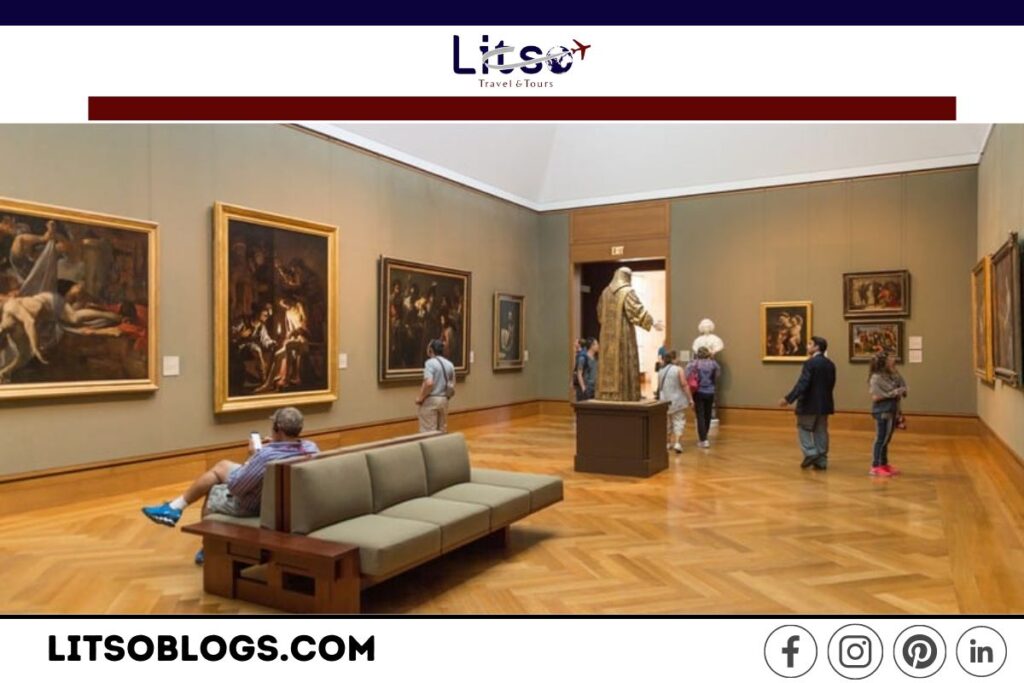The Getty Centre, a tribute to the blend of art and architecture, is tucked away in the wonderful surroundings of Los Angeles, California. This cultural gem, a part of the Getty Museum and other programs of the Getty Trust, opened its doors to the public on December 16, 1997. Talking about its legendary art and architecture, mostly this place is known as the museum only. But let me tell you that it’s not just an art museum but it’s something more than it. When I visit there it offers an exceptional experience that combines a stunning architectural masterpiece with flawlessly curated art collections and breathtaking gardens.
The time I spend there truly feels like I am out of the bustling and busy world that we live in every day. If you are visiting Los Angeles then The Getty Center is the place that will offer a calm exploration of thoughtful masterpieces that are exhibited everywhere. I really explore the place differently by having a mindful inspection of the art pieces that talk with me in the language of many meaningful signs. The purpose of this blog is you let you know the different architectural brilliance The Getty Center offers.
I cover every detail here for first-time visitors to this beautiful place so that you never miss any corner to absorb the positive energy of the art. So, come along to discover the rich history and unique blend of art and nature that make The Getty Center an iconic destination!
Historical Blend That Getty Center Hold
To truly appreciate The Getty Center, first I must give you a glimpse into its historical roots because background is important to make the front view more beautiful and attractive. And it’s the right thing to do first!
So, the story begins with J. Paul Getty, whose passion for art led to the establishment of the Getty Museum in his Pacific Palisades home in 1954. The museum expanded over the years, even boasting a replica Italian villa to house Getty’s ever-growing collection. After Getty’s passing in 1976, his vision continued to evolve.
The need for a more accessible and expansive location eventually led to the acquisition of the 24-acre campus in the Santa Monica Mountains, an architectural feat in itself. Perched atop a hill, this location not only provides a stunning vantage point of the Los Angeles skyline but also offers breathtaking views of the San Bernardino and San Gabriel Mountains to the east and the Pacific Ocean to the west.

The journey to create The Getty Center was not without its challenges, just like any masterpiece which goes through hurdles to get a rank. Architect Richard Meier was tasked with designing this cultural haven, and construction began in 1989, though completion faced delays. However, despite these hurdles, The Getty Center finally opened its doors in 1997, at a cost estimated to be $1.3 billion.
It’s The Entirety Of Architectural Masterpiece
At the heart of The Getty Center’s allure lies its architectural brilliance. Richard Meier ingeniously exploited the natural ridges of the site, creating two grids that define the campus’s spatial layout. One axis houses the galleries, while the other accommodates administrative buildings. These grids intersect, emphasizing strong visual lines throughout the campus.
The choice of materials, concrete, and steel, paired with travertine or aluminium cladding, gives the buildings their distinct character. Notably, around 1.2 million square feet of travertine were used in the construction.
The landscape surrounding the campus is thoughtfully designed, featuring numerous fountains that provide a soothing backdrop. The north promontory serves as a heliport in emergencies, while the south promontory boasts a succulent plant and cactus garden.
To enhance accessibility, a state-of-the-art automated hovertrain people mover, known as the “Getty Center Tram,” shuttles visitors between the parking garage and the museum.
Intricately designed, The Getty Center stands as a testament to human creativity, architectural ingenuity, and a deep appreciation for art. It’s a place where history and modernity merge, where art and nature coexist harmoniously, creating an experience that transcends time and space.
7 Best Art Attractions Of The Getty Center
The Getty Center is like a magical art world on a hill in Los Angeles. It’s not just a museum; it’s a place where art from different times and places comes together to create something amazing. You’ll see art that was created long ago, like incredibly detailed books from the old days and colourful paintings that hold meaning to make you feel like you’re in a different time.
But it’s not just about old stuff! The Getty Center is like a meeting point for art from all over the world. It’s the place where, you can discover art from places you might have never visited, like delicate Persian writing or bright and lively paintings from the Impressionist era.
And guess what? You’ll also get to see some of the best artwork ever made by famous artists like Rembrandt, Vermeer, Turner, and Picasso. These artists are like the rock stars of the art world, and their masterpieces are like musical hits that never get old. The collection of these attractions is listed below to explore that do justice to The Getty Centre Cost!
Also Read : 10 BEST ART MUSEUMS IN THE USA
-
Pre-20th Century European Paintings
The collection of pre-20th-century European paintings at The Getty Center is a true marvel. It showcases a remarkable assembly of masterpieces by some of the most celebrated artists in history, including luminaries like Rembrandt, Vermeer, Turner, and Van Dyck. Among the treasures housed within these hallowed walls, Rembrandt’s captivating “Portrait of Marten Looten” stands as a shining example, encapsulating the very essence of the Dutch Golden Age. The depth and breadth of this collection offer a captivating journey through centuries of European artistic achievement, making it an absolute must-visit for art lovers.

-
Drawings and Illuminated Manuscripts
For those with a penchant for intricacy and detail, The Getty Center’s collection of drawings and illuminated manuscripts is an exquisite trove that demands exploration. Spanning from the Middle Ages to the Renaissance, this collection presents a visual tapestry of remarkable craftsmanship. Among its many treasures, “The Lamentation of Christ” by Giotto di Bondone is a true masterpiece that leaves a lasting impression. Each page and stroke of ink in these manuscripts and drawings tells a story of devotion, creativity, and human ingenuity. It’s a journey into the meticulous artistry of the past that promises to enthral visitors with its beauty and historical significance.
-
Sculpture and Decorative Arts
The Getty Center’s collection of sculpture and decorative arts is a captivating voyage through time, showcasing sculptures and decorative objects from diverse cultures and epochs. Each piece offers a glimpse into the artistic expressions of different eras and regions. Notable works, such as Pablo Picasso’s “Bust of a Woman,” stand as testaments to the power of artistic innovation. The collection also boasts intricately designed pieces like the “Cabinet with Scenes of Courts and Gardens,” which provide a window into the aesthetics and sensibilities of their respective times. As you explore this rich tapestry of sculptural and decorative art, you’ll embark on a journey that transcends cultural boundaries and spans the centuries, making it an enriching experience for all who venture through the museum’s doors.
-
Photographs from the 19th Century to Present Day
The Getty Center offers a captivating journey through the world of photography, making it a haven for photography enthusiasts. Its extensive collection spans from the 1830s to contemporary works, allowing visitors to explore the evolution of this powerful art form over time. As you traverse the galleries, you’ll be greeted by iconic photographs that have left an indelible mark on the history of photography. The works of legendary photographers like Ansel Adams, renowned for his breathtaking landscapes, and Diane Arbus, known for her thought-provoking portraits, grace the museum’s walls. These photographs offer a glimpse into the unique perspectives and artistic mastery of these photographers, making a visit to The Getty Center a visual delight and an educational experience for photography aficionados.

-
Outdoor Sculpture Of Art
One of the most enchanting aspects of The Getty Center is its outdoor sculpture experience, which extends beyond the traditional confines of gallery walls. As you step into the terraces and gardens of the centre, you’ll encounter a curated selection of sculptures that seamlessly harmonize with the natural surroundings. This outdoor gallery showcases a diverse array of sculptures, each a work of art in its own right. The sculptures, ranging from contemporary to classical, offer a unique opportunity to appreciate art in an open-air setting.
The interplay between the sculptures and the serene landscape enhances the overall artistic experience, inviting visitors to engage with art in a way that transcends the boundaries of traditional Getty Center museum spaces. Whether you’re an art aficionado or simply seeking a moment of aesthetic contemplation, The Getty Center’s outdoor sculpture collection provides a refreshing and immersive artistic encounter amidst the beauty of nature.
-
The Central Garden by Robert Irwin
The Central Garden at The Getty Center is a living work of art, masterfully designed by the renowned artist Robert Irwin. It’s a place where the lines between art and nature blur, and visitors are invited to explore a unique botanical wonderland. Irwin’s vision transformed this garden into a dynamic masterpiece, where living plants and horticultural design become the medium for his creative expression.
What sets the Central Garden apart is its intricate layout. Irwin has seamlessly combined geometric precision with organic chaos, creating a harmonious balance. As you wander through this captivating space, you’ll encounter meandering paths, cascading streams, and unexpected vistas that beckon exploration. The lush and diverse plantings within the garden include a wide variety of flora from around the world. Vibrant flowers, aromatic herbs, and exotic trees come together to create a vibrant tapestry of colours and scents.
The Central Garden exudes a serene atmosphere, offering visitors a chance to escape the hustle and bustle of the city and find solace in the beauty of nature. The gentle sound of flowing water and the interplay of light and shadow add to the garden’s peaceful environment. Whether you seek a quiet spot for contemplation or an opportunity for exploration, the Central Garden accommodates both. Secluded corners invite solitary reflection, while meandering paths lead to hidden nooks and crannies, encouraging discovery and wonder. For artists and creative souls, this garden serves as a wellspring of inspiration, where the interplay of nature and artistry encourages a fresh perspective and the awakening of artistic sensibilities.
-
Vincent van Gogh’s “Irises”
“Irises” by Vincent van Gogh, housed in The Getty Center, is a masterpiece that captures the essence of the Dutch post-impressionist’s genius. The painting is a vibrant and emotionally charged work of art that immediately commands attention. The swirling, dynamic brushwork and bold use of colour create an intensity that’s truly captivating. It’s a testament to van Gogh’s unique style and vision, demonstrating his ability to infuse even simple subjects with profound depth and emotion.
Every one of Van Gogh’s iris paintings is different. He carefully watched how they moved and looked to make a range of curved shapes with lines that twisted, turned, and curled around them!
“Irises” has transcended its status as a painting; it has become an icon in the art world. Beyond its artistic merit, the artwork holds cultural significance and serves as a symbol of van Gogh’s enduring legacy. For any art lover, “Irises” is a must-see masterpiece. It’s a work of art that possesses the power to move, inspire, and leave a lasting impression. Standing before this painting at The Getty Center is an opportunity to connect with van Gogh’s passion and creativity, and to appreciate the profound impact he has had on the world of art.
Tips For Visiting The Getty Center To Have Ideal Experience
Think of the following tips for visiting a place as your trusty guide, like a friendly local who knows all the best spots. It’s important because it’s like having a friend show you around, helping you avoid hassles, find hidden gems, and make the most of your time there. It’s like having a secret code to unlock a richer and more enjoyable experience, so you can truly absorb every moment and create cherished memories. That is why, here are some tips to ensure you have an ideal experience when visiting The Getty Center:
- Check The Getty Center’s website for opening hours, ticket prices, and any special exhibitions or events. Plan your visit for a time that works best for you. Also, to avoid long lines and ensure entry, consider reserving your Getty Centre tickets online in advance. This can save you time and guarantee your spot.
- Arriving early in the day, especially on weekends, can help you beat the crowds and have a more relaxed experience. The Getty Center offers ample parking. Consider taking the tram from the parking area to the museum, as it’s both convenient and enjoyable.
- The Getty Center is spread across a hillside, so be sure to wear comfortable walking shoes as you’ll be doing some exploring on foot. Don’t rush through the galleries. Take your time to admire the art, read descriptions, and soak in the atmosphere. There’s no need to see everything in one visit.
- Don’t miss the beautifully landscaped gardens, including the Central Garden and is possible go for a visit at Getty Villa. They provide a serene escape and offer fantastic views. Review the museum’s photography policy and rules. While many areas allow photography, flash photography and selfie sticks are typically prohibited in galleries.
- Respect the art and remember to maintain a respectful distance from the artwork, refrain from touching it, and be mindful of other visitors. The Getty Center has several cafes where you can take a break, enjoy a meal, or simply grab a coffee. Use these spaces to relax and recharge.
- If there are special exhibitions on display during your visit, consider checking them out. They often feature unique and temporary displays. Also, don’t forget to enjoy the panoramic views of Los Angeles from the hilltop location. It’s a unique perspective of the city.
Los Angeles’s Cultural Oasis: The Getty Center Experience
A trip to the Getty Center Los Angeles is more than just a tour through art! it’s also a deeper look into the creativity, history, and culture of human beings. Each museum, gallery, and other place to explore presents its visitors with an original perspective on the artistic legacy of our earth. If you want to get the most out of your time at this cultural treasure in Los Angeles, be sure to investigate these highlights when you’re planning your trip there. It tells us that art is one of the few things that can cross time and space, letting us connect with the creativity and imagination of people from the past and the present. It’s a cultural light in the middle of Los Angeles that invites everyone to explore, learn, and be moved by its beauty and wonder.